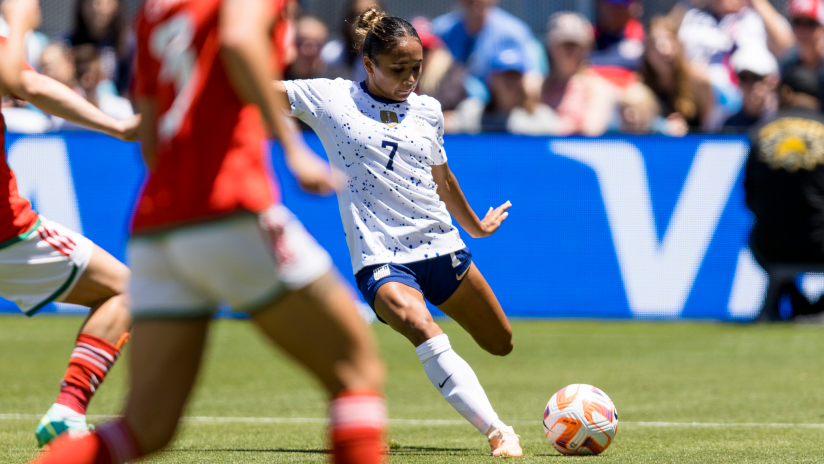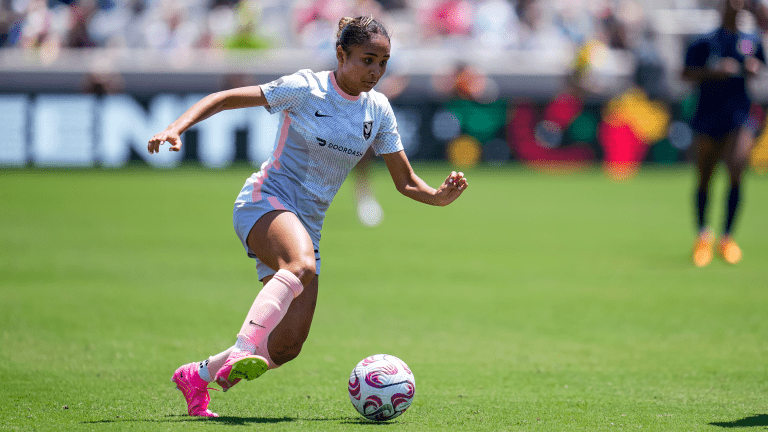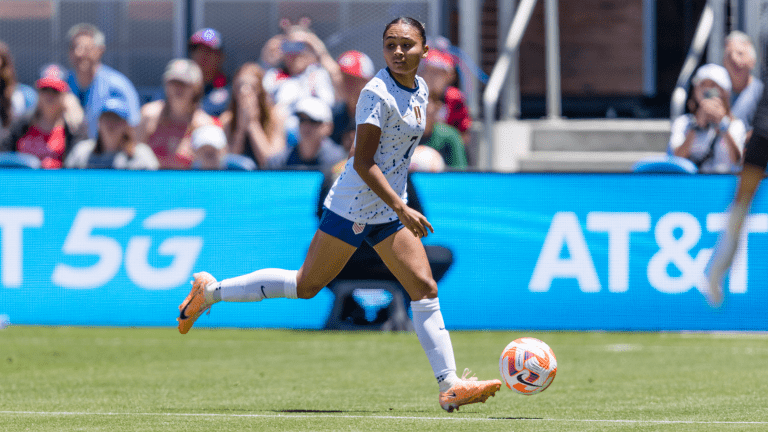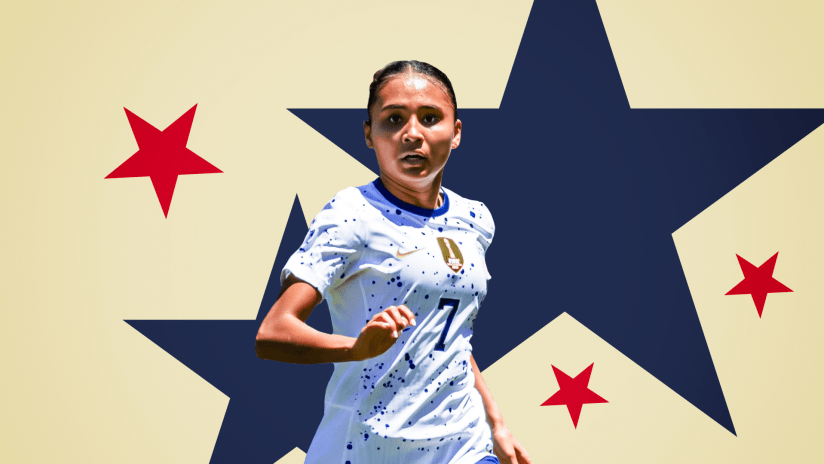With the FIFA Women’s World Cup underway in Australia and New Zealand, an 18-year-old marquee Los Angeles talent partially developed through the MLS NEXT academy infrastructure could play a key part at the tournament.
Alyssa Thompson is the youngest player on the roster for the US women’s national team, now in New Zealand attempting to do what no international football team has ever accomplished: win three World Cups in a row. That dream’s fruition would hardly be the first time the four-time world champions have managed to carve new paths while shouldering pressure, critique, and uncharted territory.
As Thompson (alongside her younger sister Gisele) developed as youth players at MLS' Total Futbol Academy, and MLS NEXT boys academy, those are the very characteristics they had to embody to prove they could cut it and excel there. For an aspirational national team that will soon rely heavily on its next generation – this summer and into the future – perhaps nobody embodies the spirit of what’s to come better than the Thompson sisters.
The early years
Thompson first joined TFA back in 2013 as a 9-year-old – a decision Mario Gonzalez, her coach for the past three and a half seasons there, said was driven by the early abilities of the Thompson girls and the supportive role their parents took in their soccer development.
Mario and Karen Thompson, both former athletes themselves, sought out TFA in the belief the local boys academy is where their girls would best develop; they’d discovered through word of mouth in LA that TFA was the place to be. The fact it was a boys team didn’t stop Mario Thompson from picking up the phone and saying: Okay, but what do you think about my two girls playing?
With early expectations laid down that they could join, but would need to cut it by the same standards as everyone else, TFA took them in.
When you’re the lone girl among boys, you stick out. And, according to Gonzalez, every now and then a parent would take issue. But then, as now, he’d simply instruct the Thompson sisters to prove yourselves.
“I think they did a lot of talking on the pitch,” Gonzalez said.
At that age, potential is raw. The development dynamics utilized by TFA were introductory. But even then, Thompson’s innate capabilities became quickly evident. Her speed and athleticism (harbingers of the elite, track-star caliber speed that would go on to define her game) stood out. But she still needed to build those tools in order to become the creative, versatile winger she is now – a process TFA played a key role in over the next decade.
That development path wound through other clubs too, including ECNL side Real SoCal, where Thompson went to play through much of her teenage years until the pandemic.
Returning to TFA
The girls left to play with Real SoCal in 2015. But in 2020, Mario Thompson called TFA president Paul Walker back up. He was curious to know if his teenage daughters could try out for the team again.
TFA had just been granted full academy status by MLS, with opportunities from the U-13 to U-19 levels. Gonzalez responded the same way he had when the girls were young: “My thoughts are, they can come back, but they have to try out. Just like everybody else. And they have to be good enough to make the team. Simple as that.”
As Gonzalez told MLSsoccer.com while thinking back to that moment, it’s one thing to have a pair of 7-to-9-year-old girls playing on a boys team as they just start out. It’s a different story to have a pair of teenage girls looking to play with teenage boys. There were initial questions the Thompson sisters had to resolve.
“I mean, pretty quickly into the scene, into the trial portion of it... I knew they were good enough to be there. I just didn't know if they could compete physically,” said Gonzalez. “I knew the mental and technical part. I knew the speed of play, I knew they had it. It was just the physical component, right? Because playing with boys at U9 is a lot different than playing with boys at U16, U17.”
At the time, he’d instructed the sisters to “show you can play at this level. Show your abilities.”

And with an unparalleled drive and ambition Gonzalez describes as endemic to both sisters, they were unafraid to prove themselves in not just the technical battles, but the physical ones too.
“They proved to me and everybody else, they wouldn't get hurt by getting in tackles, by 50/50 challenges, they would get in them,” said the sisters’ former coach. “I'm telling you, it was one of those things that you had to have been there, to witness their commitment, their dedication and their drive to [achieve] ultimately what their goal is, which is basically to be the best they can be.”
If there were skeptics before when the girls were just kids, they multiplied now that they were teenagers. Through tryouts and practice, the Thompson sisters had earned the respect of their teammates. But everywhere they went, they’d encounter complaints from a few opposing fans, players or coaches.
“I would get calls from clubs, from directors, from coaches saying, ‘What are you doing? You're allowing girls to play?” Gonzalez explained. “It waters down the league.' And I was like, wait a minute. They're just as good as any of these boys. You got to watch them play.”
Building new frameworks
As with the US women’s national team itself, players like the Thompson sisters who inhabit its elite ecosystem have repeatedly carved new frameworks into unpaved terrain.
When the sisters returned as teenagers to the Total Futbol Academy in 2020, they didn’t just confront observers’ skepticism, they also had to navigate the logistical hurdles of being the first two girls registered in MLS NEXT.

As they went through TFA’s tryouts and proved their abilities, the process started to have them officially registered with the academy. The Thompson sisters became the first female players to register in MLS NEXT on September 5, 2020, and played their first match in spring 2021 as TFA did not take part in competition in the fall of 2020.
Gonzalez said he received some initial blowback, particularly from opposing teams, but added he also started to receive praise for allowing girls to join his club, though he felt the need to temper both strains of feedback:
“After games, I was getting parents from opponents coming up to me saying... they were really on one side of the fence or they're on the other. ‘Why would you register girls? You know, my son can't play as hard as he wants because he's afraid he's gonna hurt her,’" Gonzalez said. "And I was like, ‘That's your son’s problem, not my problem.’
“Then I had other parents saying, 'Well you're doing great, you know, what you're doing is gonna set the tone for women's sports in America.' And I'm like wait a minute, I'm not trying be a trendsetter here. I'm just trying to compete.”
The hyper-focused attention (and critique) the sisters’ presence generated certainly made its way to the two teenagers as well. And while it may have initially caused a creeping doubt in both, eventually they proved themselves with their play… again.
Performing beneath the weight of the public’s eyes and expectations became a key facet of their games, and something US manager Vlatko Andonovski noted as a major asset.

Wembley, Angel City
When Thompson made her USWNT debut, she did so at the ethereal Wembley Stadium in London last October, running in for Megan Rapinoe before a crowd of nearly 77,000 opposing fans. At the time, she was still in high school, not yet professional, just 17 years old.
Thompson’s ability to shoulder that pressure with grace is among the factors Andonovski cited in explaining his decision to add her to the World Cup squad, the first teenager on a US World Cup squad since 1995.
“I mean Alyssa, what a turn of events in the last nine months. If you think about in October, she was playing youth soccer. And now in July, she will be at the biggest stage in women's soccer, in soccer in general” said the USWNT coach.
Gonzalez said he remembers talking to Thompson before she left for London. He was still her coach at the Total Football Academy. Gonzalez advised her to be herself, to enjoy it, but also: “Put on a show. Show them what you got.”
A few months after debuting at Wembley, Thompson made another big decision: to forgo college soccer and enter the 2023 NWSL Draft. She was selected No. 1 by her hometown club, Angel City FC, setting a new record as the youngest-ever No. 1 pick.
The decision to turn professional straight out of high school could very well set a trend, yet another new trail in Thompson's career many after her may follow.
In search of history
Last Friday in Auckland, New Zealand, the US began their campaign for a first-ever ThreePeat and fifth overall World Cup trophy with a 3-0 win over Vietnam. Thompson played the last 15 minutes at Eden Park as a second-half substitute for Trinity Rodman. They're back in action Wednesday night (9 pm ET) against the Netherlands in a rematch of the 2019 final.
The 23-player squad contains famous names familiar across the nation and beyond it: Alex Morgan, Rapinoe, Rose Lavelle, Julie Ertz. But for the US to succeed, the historic achievement will need to come on the wings of the untested generation. And perhaps nobody embodies that raw untested potential more than Thompson.
According to Andonovski, she’ll play an important part in their plans this summer.
“Unpredictability. She’s unpredictable. Her creativity on the field and the things that she does on the field are so hard to track because you never know what she’s going to do, whether it’s going to be a one-on-one, one-on-two, give and go, shoot left foot, right foot. She’s very very hard to track or prepare for," he said.
Gonzalez beams with pride when told of Andonovski's assessment. But he resists taking credit.
That’s Alyssa.










